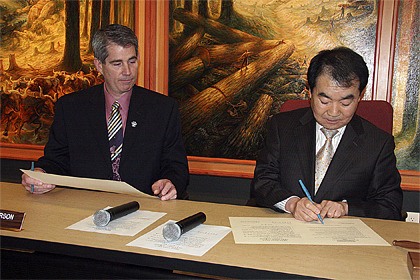As young musicians played and Snoqualmie Tribe dancers drummed and stepped, hundreds gathered to officially celebrate the opening of the new Snoqualmie City Hall last Saturday, Jan. 9, downtown.
But the dedication had a few surprises in store.
Longtime councilman Charles Peterson received the key to the city, while Mayor Matt Larson and his counterpart from Gangjin, South Korea, officially signed the document naming the two communities sister cities.
Peterson served as mayor from 1974 to 1981, and has been a councilman and planning commissioner for more than 10 years separate from that.
Larson hailed Peterson’s “absolutely extraordinary record of service,” and confirmed the city’s trust with an official key.
“The big problem with cities is that they lose their memory, and it’s gone,” said dedication emcee and local historian Dave Battey. “Someone like Charles, who has been around and been involved, can keep you out of trouble and help you understand why decisions are made.”
Larson and Ko Dae-Seok, vice-mayor of the City of Gangjin, brandished pens and signed the official sister city accord.
Speaking through an interpreter, Ko described the bonds of trust between the two cities and called for continued exchange.
“Today, we finally become sisters and brothers,” Ko said. “Even though our bodies will go back to Korea, our minds will stay here forever.”
Doug Irvine, president of the Snoqualmie Sister Cities Association, proudly proclaimed Snoqualmie and Gangjin as the world’s newest sister cities. While there is only one relationship so far, he told the crowd that international connections are just beginning.
Historic moment
The signing and key ceremony gave added poignancy to the dedication, attended by dozens of local movers and shakers, exchange students and Korean dignitaries.
“We stand on hallowed ground,” Larson said. “This site has special history.”
The site of the hall has always been in the heart of the community. From the vacant lot where city hall now stands, a visitor could see some of the oldest buildings in the community, the shops, churches and homes that formed the nucleus of Snoqualmie a century ago.
Fifty years ago, “it was a logical, central place” to build the city’s volunteer fire station, Battey said, “and, in my opinion, (is) a great and historic place for our new City Hall.”
For 107 years, the city used private homes and former businesses to do the city’s business.
“Today, we stand in a new structure built specifically for the city and her needs,” Battey said.
The new hall’s design reflects new challenges, including climate change, energy independence and technological innocation.
“Like the city’s founders, this design embodies a pioneering spirit,” Larson said.
The mayor said he and the council are committed to demonstrating that Snoqualmie’s downtown is not being abandoned.
“We have now put our money where our mouth is,” he said. “Our collective character has declared that our community is not accepting D’s and F’s, such as decline and defeat, fear and failure. Today we have every reason to celebrate a significant historical moment, and keep moving forward for the downtown as a whole.”
The dedication ceremony also lauded the public art on view throughout City Hall.
Peterson rededicated the five large paintings by Valley artist Richard Burhans, capturing the history of logging in the Snoqualmie Valley.
On behalf of the city, Peterson recognized Richard and his wife Sallie Burhans for their “continued commitment to the arts and history of the Snoqualmie Valley.”
Rotating and permanent works are also on display.



